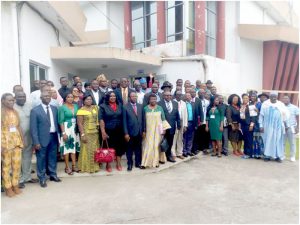By IKOME CHRISTIE-NOELLA EPOSI
The University of Buea in partnership with the Partners Enhancing Resilience for People Exposed to Risks (PERIPERI U) has launched an earthquake building code and building regulations for the mount Cameroon area.
Taking place at the Buea Mountain hotel recently, the workshop and official launching ceremony was spearheaded by the Vice Chancellor of the University of Buea, Professor Ngomo Horace Manga. Also present was the former Vice Chancellor of the University of Buea and one of the pioneer members of the project Professor Dorothy Limunga Njeuma.
The book titled “The design and enforcement of an earthquake building code and building regulations for the Mount Cameroon Area”, the ceremony brought together a plethora of personalities ranging from lecturers, students, members of the PERIPERI U and a host of others.

The 89 paged-book is an academic work from scientific knowledge and is divided in three different parts; the first part is elements of side parameters(type of soils, area concerned, etc), the second is the elements of structure, design etc and the third part is retrofitting.
The coordinator of the PERIPERI U Project, Professor Ayonghe Samuel noted that the launch of the earthquake building code and building regulations is very timely as it will enable the population of the 7 communities on how to behave or react when faced with an earthquake situation. Presentations were done on volcanic risks as perceived by the population within the 7 municipalities (Idenau, Limbe I, Limbe II, Limbe III, Tiko, Buea and Muyuka) at the flanks of Mount Cameroon by Dr. Asong Fred, background of the earthquake building code and regulations by Dr. Wantim Mabel etc.
According to the Vice Chancellor of the University of Buea, Prof. Ngomo Horace Manga, the launch of the earthquake building code and regulations falls within the context of the university’s outreach activities: “A university must engage its community in ensuring that it responds to the development objectives of the communities. If the communities have problems and address them to the university, the university has a responsibility to respond to them. If the university on its own realises that there are problems it equally has the responsibility to respond to the problems or to contribute in responding to the problems particularly when they require special expertise which usually the university may have” the VC explained.
According to Prof Dorothy Limunga Njeuma, “It’s very exciting to see something we all started as a team being realised. The main concern at the time was for us to have the possibility of monitoring earth movements around the Mt Cameroon area and if it has come out today with this code for building in the area, I believe that it still serves the same purpose but it is very important that those who are supposed to implement the findings/recommendations in this work should exploit what is in the book because building permits authorisations are not just a formality”.
Prior to the event proper, a press briefing was organised by the members of the PERIPERI U project to drill journalists on what the building code and regulations is all about so as to enable them better comprehend situations for easy and smooth dissemination to the public.
It was mentioned that this is the first ever earthquake building code which is specific to the Mount Cameroon area. The Project coordinator added that after the book launch, a series of workshops will be organised to sensitise the population on how to use the code which sets building standards for safe buildings along earthquake prone areas.
Other partners involved in the project include: the Leading Integrated Research for Agenda (LIRA) 2030 in Africa and the International Science Council.